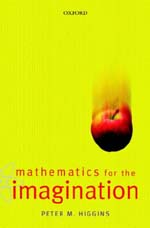'Mathematics for the imagination'

I have never before read a book that has so frequently made me think "wow, that's interesting!". "Mathematics for the Imagination" is an absolutely fascinating account of mathematical methods and discoveries and the people behind them, with the sordid histories of mathematicians through the ages jostling for the reader's attention next to their elegantly simple proofs.
The book begins with geometric problems such as "what route should an aeroplane take between London and San Francisco?" and "how long must a mirror be for you to see your full reflection?". I particularly enjoyed the explanations of the planets' apparent motion when viewed from our vantage point on the Earth and how it was eventually discovered that our solar system is heliocentric (the planets orbit the Sun) rather than geocentric (the other planets and the sun orbit the Earth) - something that we take for granted today. I found it fascinating that works written millennia ago (e.g. Euclid's "The Elements" written around 300 BC) are still in existence today (although not in their original edition).
Peter Higgins explains many interesting mathematical ideas, including why Ireland has a longer coastline than Australia and how, around 600BC, Thales of Iona calculated the height of the great pyramids using shadows. Interspersed with the mathematical explanations are potted biographies of some of the more interesting characters in mathematical history; for example, Archimedes' attempts to defend his city from the Romans by a series of elaborate weapons such as "burning mirrors" that set fire to Roman ships.
"Mathematics for the Imagination" is broken up into self-contained chapters which can easily be dipped into or devoured all at once. The more challenging proofs relating to each chapter are appended in a "For the connoisseur" chapter at the end of the book. The diagrams are very clear and equations are few and far between (though I thought some explanations would have been clearer with equations).
The anecdotes are compelling and the maths is exciting; however, this is not a book to be undertaken without prior mathematical knowledge. It is a manageable read for anyone who has taken, or is considering taking, maths beyond GCSE. If you are a maths A-level student considering taking a mathematical degree, then this book is an absolute must!
- Book details:
- Mathematics for the imagination
- Peter M. Higgins
- paperback - 238 pages (2002)
- Oxford University Press
- ISBN: 0198604602
- Buy it from Amazon UK